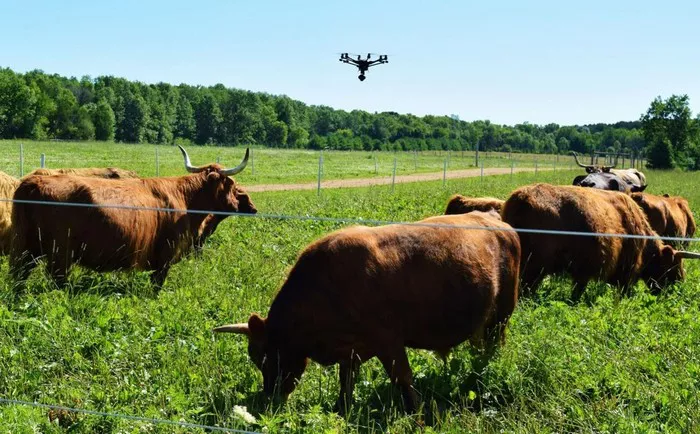Kansas State University researchers are pioneering the use of drone thermal imaging to improve management practices in cattle feed yards, potentially transforming how producers monitor animal health, pen conditions, and resource usage.
In a recent episode of the university’s Cattle Chat podcast, Haley Larson, assistant professor in animal nutrition and health at K-State Olathe, outlined the goals and early results of the project, which is focused on enhancing pen management through thermal data captured from aerial drones.
Combining Imaging and Data for Smarter Management
“To start off, we needed to determine the type of samples in these feedlot pens that could better detect pen management,” said Larson, referencing factors like environmental variation, manure output, and moisture levels. “Then, we wanted to find out if we could capture that same pen management findings in a thermal image from a drone.”
Contrary to assumptions that drone images might be too broad or imprecise, Larson emphasized their high sensitivity. “It’s a series of many images of that pen that are then combined so we can get a lot of sensitivity out of these aerial images,” she said. The thermal images are captured sequentially as the drone flies over each pen, enabling detailed heat maps that highlight subtle temperature variations.
From Pilot Tests to Commercial Feed Yards
Following successful pilot testing in smaller pens, Larson and her team expanded the research to commercial feed yards to test the technology’s real-world potential. The drones provided a range of valuable insights, including automated cattle counting and bedding temperature analysis.
“There are ways you can upload the drone’s images into an app on your phone and it will run the algorithm to count the number of cattle in that pen,” Larson explained, noting how such tools could reduce labor and human error in population tracking.
One standout discovery involved water leak detection—something often overlooked by pen riders. “We were able to detect water leaks that pen riders had missed,” Larson noted. “Drones pinpointed the thermal temperature of the bedding and showed us the coolest locations of each pen, which helped identify where leaks might be occurring.”
A Future with Real-Time, On-Farm Applications
As drone technology becomes more affordable and accessible, Larson believes these tools could be integrated into everyday operations at feedlots. “A lot of this pilot work is helping to lay the foundation for where we could go eventually,” she said, “for some real-time processing ability at the producer level or the nutritional consultant level.”
The research aims to evolve beyond specialized software, allowing producers to make real-time decisions without requiring intensive post-processing. This could represent a major step forward for the livestock industry, particularly as sustainability, efficiency, and precision agriculture become central to modern farming.
Laying Groundwork for Innovation in Animal Agriculture
Kansas State’s study underscores the growing importance of data-driven technologies in animal production. Drone thermal imaging offers a non-invasive, efficient method to monitor herd health, detect environmental anomalies, and manage feedlot conditions with greater accuracy.
As the technology matures, producers may soon be able to rely on routine drone flyovers to assess pen conditions, spot issues faster, and optimize cattle welfare—all from a mobile device.
The research continues, but early indicators show strong promise for drone-assisted solutions in commercial cattle operations. For feedlot managers, consultants, and researchers alike, K-State’s work represents a bold new frontier in livestock innovation.
Related topics:

